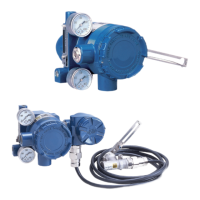2-17
Chapter 2: Installation
■ Wiring procedure
The wiring procedure for operating the device is shown below.
Step Procedure
1 Loosen the hex socket setscrew (M3) on the terminal box cover using a hexagonal wrench
(1.5).
2
Remove the terminal box cover by turning it counterclockwise.
Note
• When doing this, be careful not to scratch the painted surface with a tool or the like.
3 Remove the dustproof plug on the conduit connection.
4
Insert the cable into the conduit connection.
Note
• When doing this, be careful not to scratch the cable sheath.
5
Referring to Figures 2-13, 2-14-1, and 2-14-2, run the cable to the relevant terminal in the
terminal box.
Note
• Be careful not to make a mistake in polarity.
• Tighten the terminal screws sufficiently. The recommended tightening torque is 1.5
N·m.
6
Sufficiently waterproof the conduit so that rainwater and the like does not penetrate
inside.
Note
• We recommend the use of silicone resin based non-hardening sealant materials.
7
After attaching and sufficiently closing the terminal box cover, fix the cover in place with
the hex socket setscrew.
Caution
• Be careful to avoid injuring you fingers on the edges of the cover, the threads of
screws on the main unit, etc.
Note
• When doing this, be careful not to scratch the painted surface with a tool or the like.
Note
Model AVP302/202 has an input resistance equivalent to 400 Ω / 20 mA DC (model
AVP300/301/200/201 except for intrinsically safe type is equivalent to 300 Ω), and the
voltage between the terminals must be at least 8 V. Model AVP300/301 intrinsically safe
type is equivalent to 350 Ω, and the voltage must be at least 7 V. Check the allowable
load resistance and output voltage of the controller before use. In addition, if the allow-
able load resistance of the controller is less than above, use an isolator or the like.

